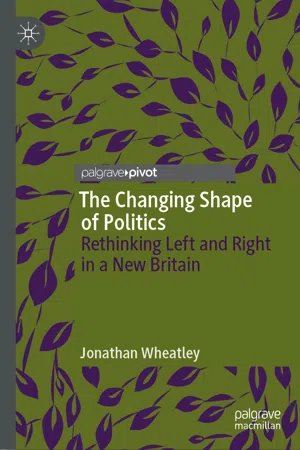The general election of 8 June 2017 was remarkable for a number of reasons. The most obvious of these was the fact that Theresa May ’s Conservative party lost its overall majority, despite enjoying an opinion poll lead over Labour of around 20% just six weeks before the vote. Another, no less remarkable development was the apparent return to two-party politics. Combined, the Conservative and Labour parties captured 82.4% of the vote, the highest proportion garnered by these two parties since 1970, and a huge leap up from the two previous elections of 2010 and 2015 when the two main parties were able to win just 65.1 and 67.3% (respectively) between them.
So, to coincide with the 2016 vote to leave the European Union , did this mark a return to the sort of politics that Britain experienced before the country joined the Common Market in 1973? Is the country once again experiencing the kind of left–right schism that we saw during the first twenty-five years after World War II with a choice for voters between a left-wing Labour Party and a right-wing Conservative Party and very little in between?
A closer look at the 2017 general election results shows that the political landscape in 2017 was very different to that in 1970. The most obvious difference, perhaps, is the way people voted in Scotland. Despite the retreat of the Scottish National Party (SNP) from its high watermark of 2015, when it won 56 out of 59 Scottish seats, the SNP remained the largest party in Scotland with 35 seats and 36.9% of the vote. The Conservative and Labour parties’ combined vote amounted to only 55.7% of the total and, because of the vagaries of the First Past the Post electoral system, they only won twenty seats between them. In 1970, however, the Conservative and Labour parties together won 82.5% of the vote in Scotland and 67 out of 71 seats.1
Second, whereas in 1970 middle class professionals predominantly voted Conservative and manual workers voted overwhelmingly for Labour , by 2017 class voting had all but disappeared. Perhaps even more strikingly, for the first time ever in 2017 more graduates voted Labour than Conservative , suggesting that the Conservative Party was no longer the party of educated professionals (Curtice 2017).
Age also proved a far more significant predictor of voting behaviour in 2017 than in previous years. Although later evidence suggested that initial reports of a “youthquake”, a massive leap in turnout amongst 18–24-year-olds, was either exaggerated or simply not true (Prosser et al. 2018), those young people who did turn out to vote predominantly voted Labour , whilst older citizens tended towards the Conservatives. Overall, therefore, by 2017 the class-based voting that prevailed throughout much of the twentieth century had given way to a divide in which age and education were far more important predictors of voting behaviour.
Finally, what separated Conservative and Labour supporters in 2017 was more than just about left and right. According to data from the British Election Study (BES) , a majority of those who voted to remain in the EU in the 2016 referendum voted Labour in 2017, while less than a quarter voted Conservative . Amongst those who voted to leave, however, more than a half voted Conservative , while around a quarter voted Labour (see below). Moreover, according to the NatCen Mixed Mode Random Probability Panel from July 2017, just 9% of those who strongly believed immigration enriched culture voted Conservative (down by 8% since 2015), while 61% voted Labour. Of those who strongly believed immigration undermined culture, 58% voted Conservative (up by 20% since 2015), while 28% voted Labour (down by 5%) (Curtice 2017: 13). Thus, issues of culture and identity, specifically those relating to Britain’s place in the world, appeared to represent a significant ideological marker for party support.
The ideological cleavage that divides British voters today is the main topic of this book. I argue that in Britain it is not only a divide between left and right in the economic sense that determines how people vote today, but it is also about a deepening divide between cosmopolitans and patriots, or, in the words of David Goodhart, between cosmopolitan “Anywheres” and rooted “Somewheres” (Goodhart 2017). This, I argue, is a consequence of globalisation that has created “winners” and “losers” (Kriesi et al. 2006, 2008) as national governments lose their capacity to mitigate the most negative consequences of globalisation amongst their most vulnerable citizens. It is this factor, I argue, that is giving rise to new patterns of party competition both in Britain and elsewhere in Europe and illustrates why the world in 2017 was a very different place to the world in 1970.
The remainder of this chapter will begin by looking at how traditional patterns of voting in the UK have changed since 1970. It will look at the changing impact of socio-economic status on voting behaviour, arguing that from the 1990s onwards not only the Conservatives but also the Labour Party increasingly began to target middle class voters. It will then look at voting patterns in Scotland and Wales, especially in the wake of the establishment of devolved parliaments there and most recently following the 2014 independence referendum in Scotland. It will go on to analyse the results of the 2017 general election in comparison with the election two years previously. In particular, it will explore the swings that were observed across the country and will present evidence that these swings can be explained, in part at least, by the aftermath of the EU referendum and the apparent polarisation it has engendered. The final part of the chapter will take a look across the Channel to see whether or not we find similar trends to those we observe in Britain on the near continent. In doing so, it will identify a phenomenon that is increasingly becoming a feature of European politics—the rise of populist r...
